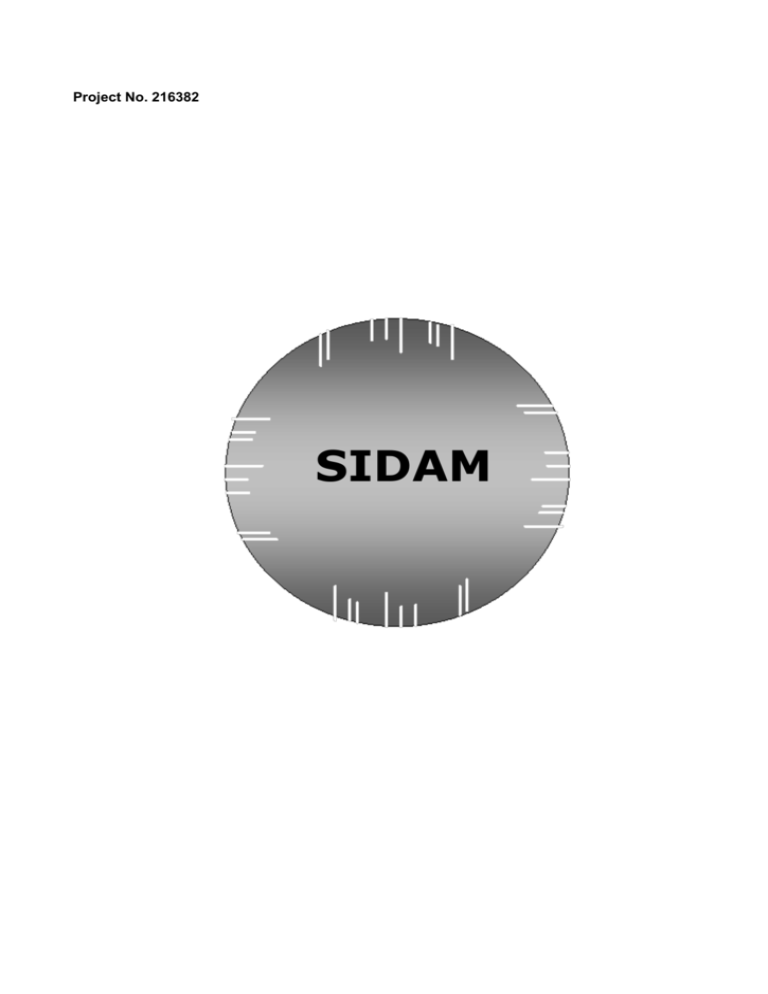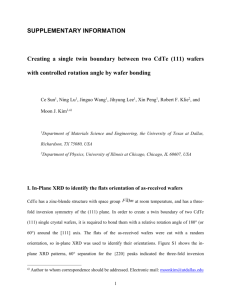Publishable Summary Period1
advertisement

Project No. 216382 SI D A M 1. Publishable summary SIDAM SIDAM The aim of this project is to discover how to derive quantitative, predictive information from X-ray Diffraction Imaging (XDRI), and thus to enable a new metrology of wafer inspection. In detail the objectives are: • • • • • To model the stresses around microcracks and slip bands in silicon wafers To model the XRDI images observed on wafers with a variety of microcrack and slip patterns To model the relationship between the above stress patterns and Rapid Thermal Annealing (RTA) failures To verify the above models by controlled nanoindenation, XRDI and RTA experiments To obtain a procedure for predicting likely catastrophic wafer failure during processing. This will be usable in several ways by semiconductor manufacturing companies: • • • to avert catastrophic failure by preventative metrology, to diagnose catastrophic failure in a problem-solving mode, to qualify all tools and wafer-handling procedures against the introduction of “killer” microcracks. Silicon wafer are always, to some extent, damaged during handling and shipping. This can arise either through contact with the cassettes used for transport or the grips of the handling tools. All wafers that we have examined show microcracks at the wafer edges. During thermal processing, some microcracks grow, resulting either in generation of slip bands and loss of device performance or catastrophic total wafer breakage. In the latter case alone, the estimated cost in lost production time taken to stop the line, recover the broken wafer, clean and restart the affected tool is estimated1 to be $2.5M per annum for every 300mm silicon fab line in the world. X-ray Diffraction Imaging, also known as X-ray Diffraction Topography, is a metrology that reveals the strain associated with internal defects, such as buried microcracks and slip bands. (Fig 1) However, wafers that produce perfectly satisfactory devices show defects and it is not known which ones are dangerous to the manufacturing process. The objective of the project is to develop a rapid imaging metrology that will identify wafers that are in danger of failing by catastrophic fracture. The BedeScan x-ray tool2 enables the key near-edge regions of a 300mm wafer to be scanned in 15 minutes, the whole wafer taking 30 minutes. The aim of the project is to quantify this technique to enable process-critical defects to be identified. 1 Source: International SEMATECH Industry Economic Model v8.1ss D.K. Bowen, M. Wormington & P Feichtinger, A novel digital X-ray topography system, J. Phys. D 36 A102 (2003) Patent granted in 2004 2 2 This is being achieved by a strategy of introduction of controlled damage through use of nanoindentation and quantification of local strain by x-ray and micro-Raman measurements. Detailed modelling of the impact of microcracks due to the associated strain fields is being done by finite element calculations. • Baseline: the interpretation of XRDI BedeScan™ images is purely qualitative. The total integrated intensity for an image segment can be measured but the relationship of this to the stress intensity is unknown. Performance indicator: the project aims to produce a verified program for quantitative modelling of XRDI images of a given stress pattern. • Baseline: the stress distribution around a slip band formed by thermal relaxation of stress concentration spots is not known. Performance indicator: the project aims to produce a verified program for modelling such distributions. • Baseline: The mechanical effects of rapid thermal annealing upon wafers containing stress concentrations are not known (or at least not publicly known). Performance indicator: the project aims to produce a verified program for modelling such effects. Progress to date The Consortium has worked together in an extremely positive manner and close scientific links have been made between all partners. In all of the outputs listed below, there are co-authors from several partners, in one case this being all partners. Mechanisms for sample preparation and distribution have worked extremely smoothly, early establishment of sample numbering and handling protocols removed potential confusions. All patners have willingly and promptly fulfilled their obligations to requests in an exemplary way. Jordan Valley Semiconductors UK have contributed resource to the project over the past year with no guarantee, at the time of reimbursement. There has been an outstanding spirit of cooperation between the partners. Despite administrative difficulties associated with the change of industrial partner, the scientific progress has been good. Micro-Raman measurements have been impressively successful at probing the damage in the close vicinity of and just below nano-indents. Specifically we have shown that before thermal treatment Phases of Si-III are observed at the centre of the indent Amorphous Si (α–Si) is observed at the side wall of the indent Compressive stress peaks at ~ 0.5GPa at the indent edge for the 500mN indents. Tensile strain peaks at ~ 3.2GPa close to the centre of the 500mN indents. After thermal treatment, we have shown that No phases of Si were observed apart from Si-I α–Si and Si-III transformed to Si-I Compressive strain peaks at ~ 0.1 GPa for the 500mN indents. Tensile strain peaks at ~ 0.34 GPa for the 500mN indents. Significant strain relief occurs, strain reduction being of the order of a factor of 10. 3 Tensile peak is no longer at the centre of the indent, but offset towards the indent edges. Raman Spectra obtained using UV laser light, which has a penetration depth (dp) of ~ 9 nm compared to usual the Ar+ laser which has a dp ~ 565 nm penetration depth, show only compressive strain throughout the indent. Scanning transmission electron microscopy measurements showed the presence of voids and associated cracks directly below the indent, providing a direct physical explanation of the stress reversal. Good qualitative agreement was found between the strain fields surrounding indents, modelled using finite element methodology, and the images in the X-ray diffraction images. Plastic deformation associated with controlled indents has been observed both at room temperature and more strikingly when maintained at high temperature, where the plastic deformation develops through dislocation propagation away from the damage site into the wafer. X-ray diffraction images taken to date have shown plastic deformation originating at the wafer edge following rapid thermal annealing. The slip bands appear strongly in the x-ray diffraction images as illustrated in Fig S1 below but in wafers containing controlled indents, no correlation has yet been found between origination of slip bands and indents. 4 Fig. S1: XRDI image of a wafer (SIDAM-28) subjected to Rapid Thermal Annealing Finite element modelling code is now in place to simulate the dislocation creation and propagation under external load in different directions. Work is now in progress to integrate the finite element strain modelling with the dislocation dynamics code, thereby enabling the dislocation configuration associated with the indentation to be simulated. The project is on course to deliver a quantitative metrology to determine the statistical probability of wafer breakage during semiconductor processing. The typical loss of wafers through breakage is of the order of €2m per annum for a single fabrication line and as a result of the SIDAM project will be significantly reduced. Publications Danilewsky, A. N., Wittge, J., Rack, A., Weitkamp, T., Simon, R., Baumbach, T., & McNally, P. J. 2008, "White beam topography of 300 mm Si wafers", Journal of Material Science : Materials in Electronics, vol. 19, p. S269-S272. Danilewsky, A. N., Rack, A., Wittge, J., Weitkamp, T., Simon, R., Riesemeier, H., & Baumbach, T. 2008, "White Beam Synchrotron Topography Using a High Resolution Digital X-Ray Imaging Detector", Nuclear Instruments and Methods in Physics B, vol. 266, no. 9, pp. 2035-2040. Rack, A., Riesemeier, H., Zabler, S., Weitkamp, T., Müller, B. R., Weidemann, G., Modregger, P., Banhart, J., Helfen, L., Danilewsky, A. N., Gräber, H. G., Heldele, R., Mayzel, B., Goebbels, J., & Baumbach, T "The high resolution synchrotron-based imaging stations at the BAMline (BESSY) and TopoTomo (ANKA)", in SPIE: Developments in XRay Tomography, pp. 707780X-1-707780X-9. Allen, D., Wittge, J., Zlotos, A., Gorostegui–Colinas, E., Garagorri, J., McNally, P.J., Danilewsky, A.N. and Elizalde, M. R. 2009 “Observation of nano-indent induced strain fields and dislocation generation in Silicon wafers using MicroRaman Spectroscopy and White Beam X-Ray Topography” Thin Solid Films, in press. Project Coordinator: Prof Brian Tanner Department of Physics Durham University South Road Durham DH 1 3LE UK Email: b.k.tanner@dur.ac.uk The website URL is www.sidamproject.eu 5 6







